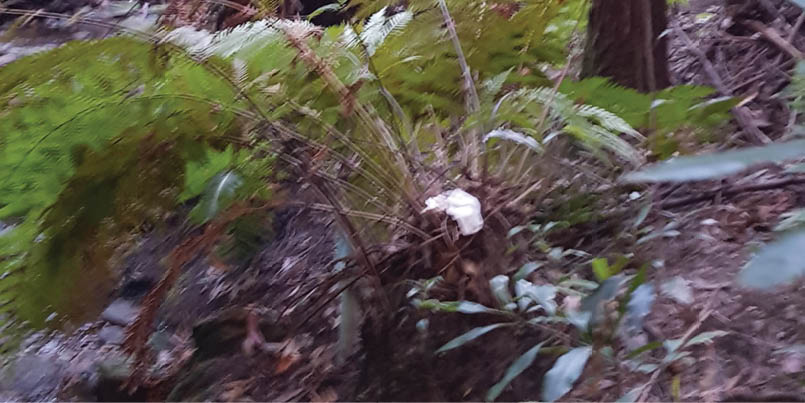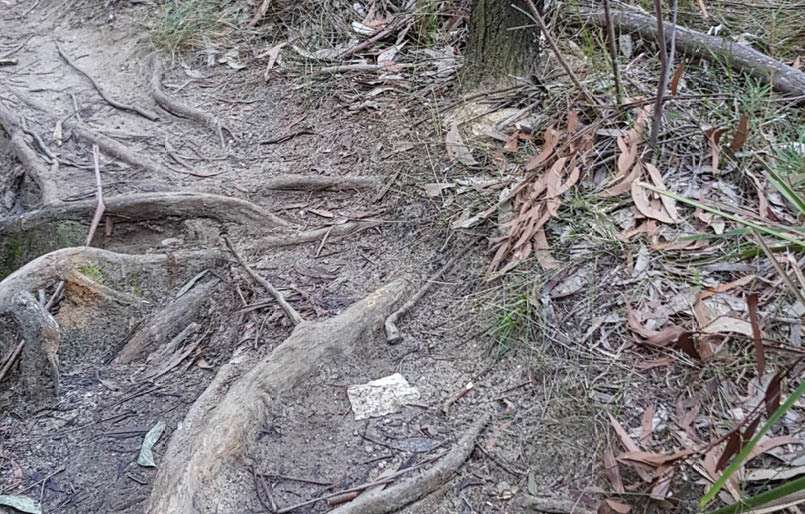{{{description}}}

This track has at least four good sized waterfalls, streams that run into the main creek with lots of yabbies and along the way, if you are lucky, you may just spot a lyrebird, and at night you will even discover an abundance of glow worms in the caves. Then down to the end of another street I get to another three waterfalls. But wait, there's more. On the other side of the highway I have another rather impressive walk which has even more waterfalls. If I say so myself the Blue Mountains is the most beautiful spot to live in, which makes me feel very privileged to be living here.
The Blue Mountains are a popular tourist spot, so on glorious days the mountains become pretty busy. These less well known tracks are a great chance for locals to disappear, away from the typical tourist destinations and madding crowds. Every time I go into the local forest I find more people exploring this area, which is good, especially seeing the little people out. These walks are awesome for kids. In fact I had my 11 year old nephew, Benjamin come and stay with me recently and I took him down to see the falls, then back again at night to see the glow worms, then again the next day to explore further down the side streams. What made it really special for him was when he saw not one, not two, but three lyrebirds in the bush. He was amazed and now is hooked and can’t wait to get into the bush again. Oh, by the way, did you know glow worms are actually a larvae and not a real worm, they eat their own vomit and have four butt holes? Yes, really. After Benjamin went home and told his sister Annabeth aged six all about his amazing adventure, I now have Annabeth and my other nephew Samuel booked in for a weekend exploring the local bush tracks.
Local tracks and more rubbishWhat I am also noticing more in my local tracks is seeing more rubbish being dumped in the bush - not good. I have seen coffee cups, tissues, used doggy bags hanging in trees, food wrapping and bottles just thrown away. Well at least Benjamin got some bottles for return and earn and I do try to collect a lot of rubbish when I am down there to do my bit. But really, we should all know the motto "if you carry it in, you should carry it out", right?
Also when I go on bigger walks or canyons and especially known tourist walks, I sometimes see a lot of rubbish, a lot of tissues lying around in the bush or even food scraps. Sometimes when women go into the bush to do a pee, or even when anyone blows their nose, tissues can be left behind. I saw a tissue even in the middle of a tree fern, yes right in the middle of the fern. This really annoys me and it is not good the environment as there is an easy solution.
My views are shared by my MP, Trish Doyle.
It was important - for some self care - to take a couple of days out of the office, away from emails, phone calls, problem-solving and walk. Given that school holidays and COVID-19 restrictions mean our local Blue Mountains bushwalks are much busier than usual at this time of year, I was keen (and surprised) to see how the tracks were coping with it all ...
Whilst some people don't mind the shrill sound of screeching children's voices or the very large and loud groups of Sydneysiders who haven't ever explored the bush, one must be prepared to encounter this! I met some lovely people, thrilled with the natural environment!
Sadly, though, I was gobsmacked by the amount of litter: chocolate and lolly wrappers mostly, but so much tissue and silky baby wipe rubbish throughout the bush. Chips and biscuits were thrown into our waterways ... and way too many people are using the bush as a toilet. Just awful.
Let's welcome people to our bush, to our local businesses and shops, for a break away ... but let's also respectfully remind people to:
Leave nothing but your footprints;
Take your rubbish with you;
Spatial distance;
Stop talking so loudly every now and again - hear the quiet of wilderness, waterfalls, wind in the trees, birdsong.
Enjoy!
“... tissues can be left behind.
BWA December 2020 | 51

Benefit of the doubt or poor planning ... Yes, some rubbish and tissues can easily fall out of your pocket, or rucksack, I get it as it can happen. As when you do look at some of the rubbish found like food wrappers and tissues in the middle, or just on the side of the track it looks like it could have easily fallen out of pockets. Other times, like when you see a full doggy bag in the fork of a tree, tissues in the middle of a fern tree and a coffee cup just off the track, this is blatantly obvious that it has been dumped. Now why would people do something like that? I don’t know. I doubt those kind of people would be reading this emag. Perhaps seeing rubbish there, you think well they did it, so why not, or you don’t care or simply poor planning and lack of care to carry rubbish with you, or as a friend says a lack of connection to the environment. The psychology and reasons for littering are in the articles.
What we can do about itWe can do a lot about it, and it is pretty simple, really. Carry a biodegradable rubbish bag or spare zip-lock bags. Ensure your rubbish does not fall out of pockets and pick up what you can. There are so many articles on littering, it is a huge problem worldwide. You can even join an organisation, Clean Trails. Another good friend told me a tip for rubbish for multi day hikes. Strap a two litre milk bottle to the outside of a pack as a rubbish bin. Take note, you need to empty out the rubbish after your hike as you can’t recycle the bottle filled with rubbish.
Ladies, please carry a small zip lock bag in your pocket and when you pee take your tissue paper with you, pack it in the zip lock bag. Or even use a pee rag if you dare. Everyone, if you blow your nose or wipe your face, or whenever you use a tissue, ensure it is secure somewhere and carry it out with you please. This is a simple solution and yet so effective, the environment, and other hikers, will appreciate the effort you put in to keep the environment in its natural form. Depending on the environmental conditions some tissue paper will take from one to three years to decompose. Think of that next time you use a tissue.
Rubbish breakdown – or notI have compiled a table showing how long certain forms of rubbish break down in landfill conditions. The information comes from difference sources such as WWF Australia, New Zealand Science Learning Hub and of course some other scientific journals.
You are probably asking me right now, how do we actually know how long this stuff takes to break down since plastic bags have only been around for about 60 or 70 years so we have not had a chance to wait 450 years to watch a bottle break down. Well, I'm glad you asked. Scientists do lots of experiments to measure biodegradability on different products, such as a respirometric test which measures the rate of respiration of microorganisms that break down the
Tissues in the middle of a fern tree
52 | BWA December 2020


Environmental impactsReally, it is so hard to find where to stop with this article but I will try to keep it to a minimum. Apart from the obvious aesthetic unappealing sight of rubbish, the environmental impacts are significant even though most people can’t see it during or after it breaks down.
Firstly, let’s talk crap, dog poo in our urban waterways. Dog poo contains a lot of nitrogen and phosphorus. Nitrogen and phosphorous can strip oxygen from the surrounding environment. All creatures rely on oxygen so when poo runs down into streams it can deplete the oxygen in waterways and create a better environment for bacteria, thus contamination and sickness can occur when consumed. Disease from animals known as zoonotic infections, such as giardia can occur. Algal blooms can also occur, which can kill fish and wildlife.
Plastic bags break down into very small pieces over the span of years and they can wash down into waterways and the oceans. Animals and aquatic creatures consume this water with the particles of plastic. Plastic bags are made of polyethylene, which is derived from gas, petroleum, colours and
some pretty harsh additives. Would you like to eat this and think of what it can do to you if you do eat it? Then think of the ecosystem. I need not say more; there is already a plethora of information available if you care to research.
ActionSo, food for thought, please think of this next time you see some rubbish out on the trails and parents please ensure the kids, or you, don’t throw your rubbish into the bush. Carry a spare biodegradable rubbish bag, or zip lock bags in your pack and after your walk, disposing of it thoughtfully in the nearest rubbish bin. However, don’t think that if the bag is biodegradable it is fine to leave it in the bush to degrade. No way, that is so not cool, remember if you carry it in, you should carry it out.
If you see a tourist or someone littering in the bush, you can pick it up and say to them, oh you dropped this. In the case of doggy bag and doggy poo, and if you know who left this you can impress them with your knowledge and say "Did you know dog poo is bad for the environment because it harbours viruses, bacteria and parasites, excess nitrogen and phosphorous and the plastic bag you
Tissue on the track
54 | BWA December 2020


stored it in will break down in about 10 to 20 years?" Also, for extra points, offer them a biodegradable rubbish bag. Or take photos of them and shame them on social media. The NSW Food Authority names and shames restaurants when they do the wrong thing and all the information is available for public viewing, so why not do it on social media for people who litter our beautiful bush? In fact the Thailand authorities will ship rubbish back to you and then you will be registered with the police for littering in a national park. Not a bad idea, I say ...
Oh, can you also be a role model and teach the next generation how special our nature is and always to do the right thing when it comes to rubbish and our environment? And you know what, the best part of this is, it's a win-win for the environment and people as we all benefit from it. So go out there and be responsible, teach a few people some lessons and enjoy yourself while looking after this planet we all live on.
Oaklands Falls, or now named Lyrebird Falls by Benjamin due to sightings
BWA December 2020 | 55